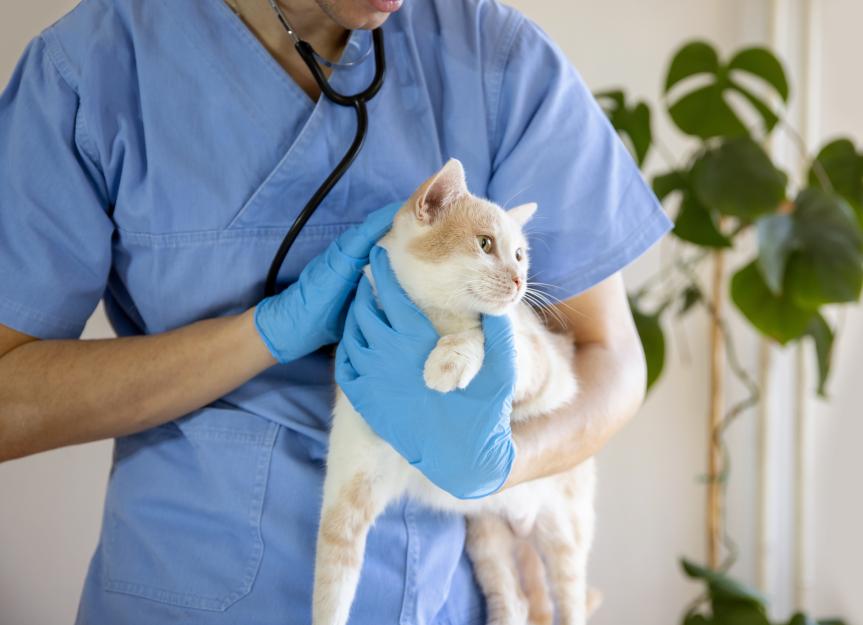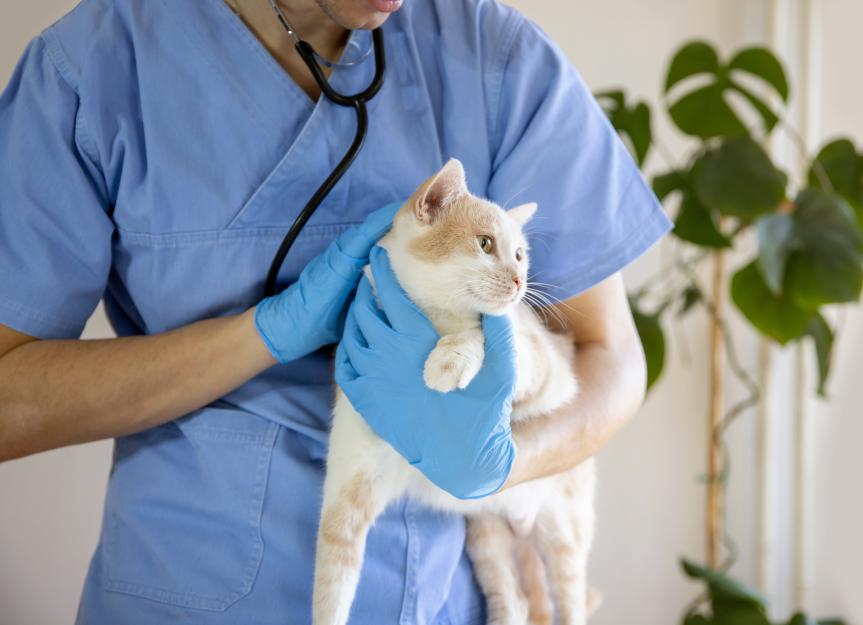
While acid reflux is much more common in dogs, cats can have it as well.
Acid reflux in cats, also called gastroesophageal reflux disease (GERD), occurs when contents from the stomach travel backward into the esophagus. This leads to irritation and inflammation (swelling).
Key Takeaways
- Acid reflux in cats happens when stomach acid flows back into the esophagus, often due to inflammation or injury.
- Symptoms include vomiting, regurgitation, drooling, and poor appetite.
- Treatment includes acid reducers, GI motility meds, and dietary changes.
- Prevent reflux with safe feeding, medication practices, and avoiding foreign objects.
What Is Acid Reflux in Cats?
Acid reflux happens when stomach acid and/or food travels from the stomach back into the esophagus, the tube that links the mouth to the stomach.
In cats, the most common reason that stomach acid comes back up is underlying esophagitis, or inflammation of the esophagus.
If anything leads to inflammation and narrowing of the esophagus, it affects the normal travel of food from the mouth to the stomach.
This change in flow can result in stomach acid moving backward and getting into the esophagus, leading to further irritation of the lining. This can be very uncomfortable for affected cats.
Acid reflux in cats is generally not considered a medical emergency.
However, this could become more urgent if your cat were to stop eating or be unable to keep their food down. In that case, they should be seen as soon as possible.
Causes of Acid Reflux in Cats
Acid reflux in cats can be caused by various things, from an anatomical abnormality that they were born with to an injury to the esophagus.
The most common cause of acid reflux in cats is injury to the esophagus. This can occur after a surgical procedure, being given certain medications, or eating things they shouldn’t.
Gastroesophageal reflux can be a complication following a medical or surgical procedure. When a cat goes under anesthesia, they often have a tube placed in their airway that is connected to inhaled gas anesthesia.
If a cat is fed before anesthesia and vomits around the tube, it can lead to stomach acid traveling up and burning the esophageal tissue. Also, if a feeding tube was put in place and has moved to the wrong location, this can also lead to acid reflux.
Acid reflux in cats occurs when contents from the stomach travel backward into the esophagus. This leads to irritation and inflammation (swelling).
Doxycycline is a common antibiotic prescribed in veterinary medicine. In cats, doxycycline can lead to stricture (narrowing) of the esophagus if the pill is given without following up with several milliliters of water to wash it all the way down.
If the pill gets stuck in the esophagus it damages the tissue, leading to narrowing of the opening and future struggles with acid reflux.
Eating things cats shouldn’t eat (like strings or toys) can lead to them getting stuck in the esophagus at the thoracic inlet, the hole that the esophagus travels through on its way to the stomach.
Even large hairballs can get stuck here when a cat is trying to vomit them up.
Anything stuck in the esophagus can cause secondary inflammation and narrowing of that pathway. Ingesting chemicals or even hot canned food can also lead to trauma through chemical or thermal burns.
Occasionally, cats are born with or develop anatomical problems that can cause acid reflux. Hiatal hernias, when part of the stomach pushes through the diaphragm, can cause secondary GERD.
Also, vascular ring anomaly (where part of a blood vessel grows abnormally, trapping the esophagus) or diverticulum (abnormal pockets in the esophagus) can occur in rare patients.
Megaesophagus, a condition where the esophagus is too big and not properly sending food from the mouth to the stomach, can also lead to acid reflux.
Acid reflux can occur in cats of any age, gender, or breed. Fortunately, it’s not a common condition in cats.
How Veterinarians Diagnose Acid Reflux in Cats
Unlike dogs, cats are not often diagnosed with acid reflux. Most cats with acid reflux have a history of either an abnormality with their esophagus or trauma to the esophagus.
If your cat has symptoms of GERD and has a history that could include possible esophagus abnormalities, your vet may recommend several tests:
-
If they are unable to note any changes on normal X-rays, they may recommend contrast tests where your cat is fed barium before being given X-rays. The barium lights up bright white on the X-ray, so it’s easy to tell if there is a narrowing.
Be sure to talk to your veterinarian to find out if you should withhold food from your cat before an appointment.
If you happen to see your cat vomit or regurgitate, try to get a video that you can share with your vet.
Treatment of Acid Reflux in Cats
Acid reflux is often treated with acid-reducing medications to prevent further damage of the esophagus from stomach acid. Medications like famotidine and omeprazole are commonly prescribed.
Also, your cat may need medication to help with keeping things moving through their GI tract, so they don’t get backed up. Cisapride is a common prokinetic that may be prescribed.
Sucralfate is a medication that is often mixed with water to make a slurry that can coat an irritated esophageal lining to provide some relief.
If there is trauma to the esophagus, your vet may prescribe antibiotics, like Clavamox, or steroids, like prednisolone.
Rarely, cats may need a surgical procedure called a balloon dilation to try to open the narrowed part of their esophagus, or they may need a surgical repair if there is a hernia or anatomical defect.
Most cases of acid reflux are managed rather than cured.
Recovery and Management of Acid Reflux in Cats
Medications can provide some relief and get your cat more comfortable within a few days.
Your vet may recommend a canned or liquid diet if your cat is struggling with swallowing. Palatable urgent-care diets (like Hill’s a/d canned food) may be recommended to help meet your cat’s caloric needs while their esophagus is healing.
Prevention of Acid Reflux in Cats
Ways to prevent acid reflux in cats include:
-
Withhold food and water after midnight the night before any procedures where your cat is undergoing anesthesia. This will reduce their risk of vomiting and burning their esophagus.
-
If your cat is prescribed doxycycline, be certain to give them at least 5 mL of water by syringe after you give them their pill.
-
Keep any strings or toys with strings out of sight and out of reach to reduce the chance that your cat will eat a foreign object.
-
If you need to heat canned pet food in the microwave, do short bursts on low power of 10–15 seconds before thoroughly mixing and testing on the inside of your wrist to avoid any hot spots, which can burn the esophagus lining.
-
Keep any chemicals sealed tightly and in cabinets that cats have no access to.
-
If your cat is vomiting more than once a week, get them to a veterinarian for prompt treatment to lower their risk of damaging their esophagus lining from chronic vomit and contact with stomach acid.
Acid Reflux in Cats FAQs
How do you treat acid reflux in cats?
Acid reflux is usually treated with antacids and medications that help movement of digested food through the GI tract.
What is a stomach acid reducer for cats?
Both famotidine (Pepcid) and omeprazole (Prilosec) can be dosed for a cat. Always talk to your vet about proper dosing before giving your cat any medication.
What should you do if your cat has high acidity?
If your cat has lots of stomach acid, ask your veterinarian about possibly giving them an acid-reducing medication.
What does indigestion look like in cats?
Indigestion can show up as vomiting, poor appetite, or excessive salivation (drooling) in cats.
When should I worry about cat regurgitation?
If your cat is regurgitating more than just an occasional hairball, say once every two to four weeks, talk with your vet.
How do you treat acid reflux in cats who are vomiting naturally?
Acid reflux is not common in cats. If your cat is vomiting often, talk to your vet.



